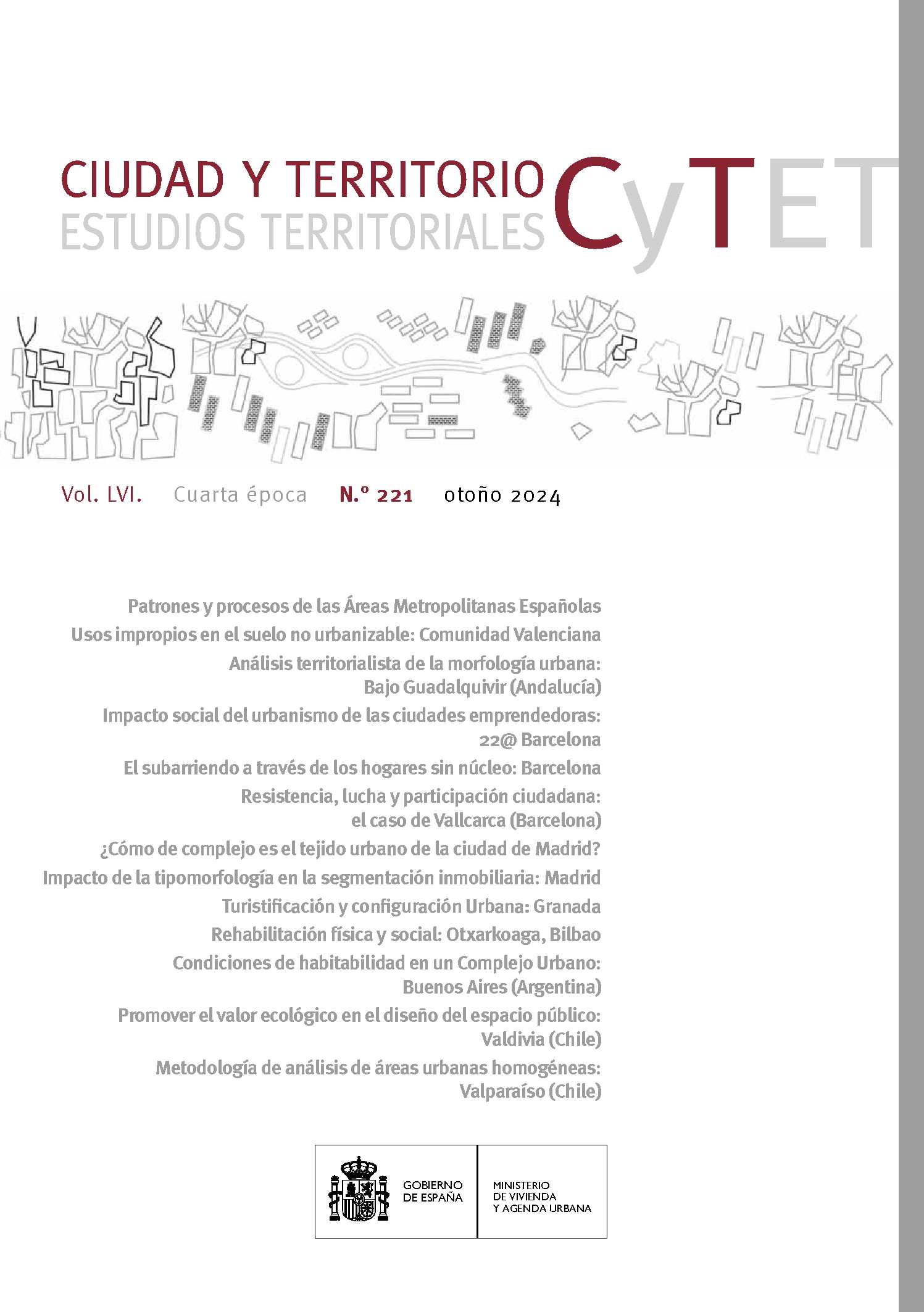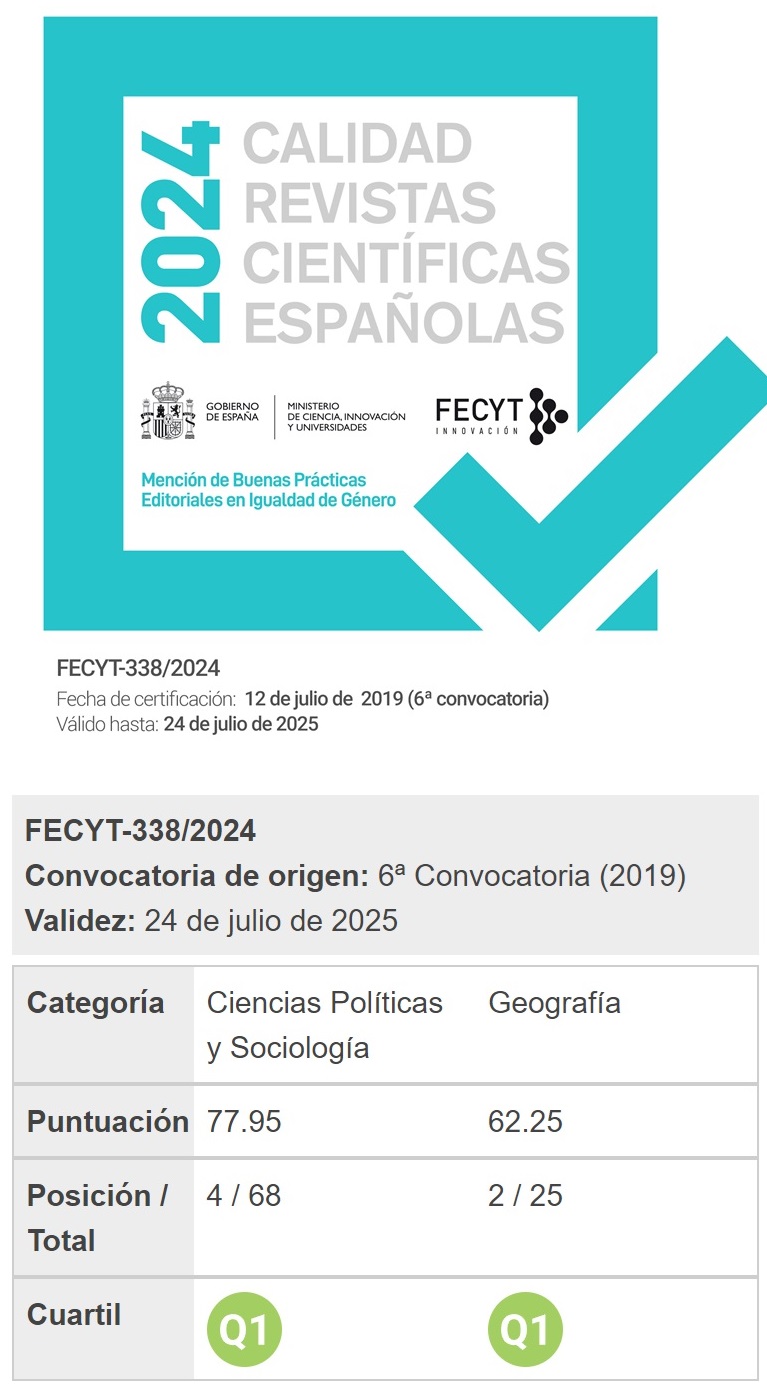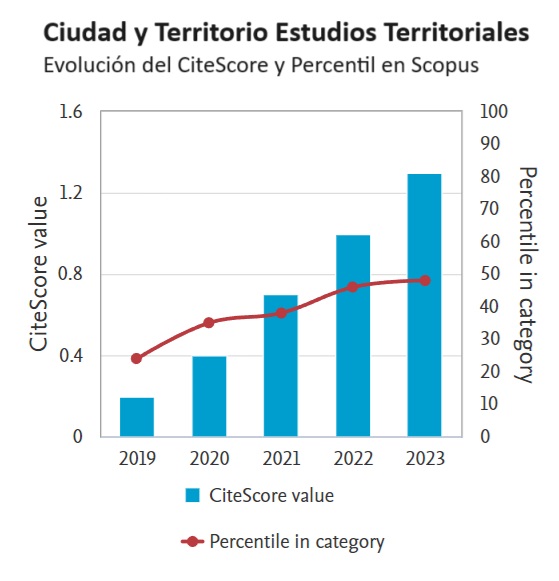Resistencia, lucha y participación ciudadana: el caso de la renovación urbanística de Vallcarca (Barcelona)
DOI:
https://doi.org/10.37230/CyTET.2024.221.6Palabras clave:
Renovación urbana, Participación ciudadana, Conflicto social, EmpoderamientoResumen
En esta investigación se presentan los resultados de un estudio cuyo propósito fue conocer cómo los cambios urbanísticos en el barrio son percibidos y afectan la vida de sus residentes, al tiempo que activan comportamientos de participación frente a la intervención. Para ello se hicieron entrevistas semiestructuradas a los residentes del barrio de Vallcarca además de realizar observaciones participantes. El análisis de los datos recogidos evidenció una sensación de pérdida generalizada en los vecinos tanto de espacios públicos como de redes sociales, lo cual los ha llevado a querer recuperar un poco de esta identidad, aumentando la participación ciudadana en la toma de decisiones. También se comentan las implicaciones desde el punto de vista de las intervenciones urbanísticas así como de la gestión de la administración pública sobre el espacio público y la participación.
Descargas
Citas
AFZALAN, N. & MULLER, B. (2018): Online Participatory Technologies: Opportunities and Challenges for Enriching Participatory Planning, Journal of the American Planning Association, 84(2), 162-177, https://doi.org/10.1080/01944363.2018.1434010
ASAMBLEA VALLCARCA. (2016): Carregades de raons. Barcelona. https://assembleadevallcarca.files.wordpress.com/2016/02/carregades-de-raons2.pdf
AYUNTAMIENTO DE BARCELONA (2016): Resultat del concurs d'idees per a Vallcarca. Barcelona. Ecologia, urbanisme i mobilitat. http://ajuntament.barcelona.cat/ecologiaurbana/ca/concurs-vallcarca
AYUNTAMIENTO DE BARCELONA (2018): Modificació del pla general metropolita al barri de Vallcarca. Barcelona. http://ptop.gencat.cat/rpucportal/AppJava/cercaExpedient.do?reqCode=veureDocument&codintExp=283339&fromPage=load
AYUNTAMIENTO DE BARCELONA (2019): Pla BUITS. Barcelona. Ecologia, urbanisme i mobilitat. http://ajuntament.barcelona.cat/ecologiaurbana/ca/pla-buits
BAKICI, T. & ALMIRALL, E. & WAREHAM, J. (2013): A smart city initiative: the case of Barcelona. Journal of the knowledge economy, 4(2), 135-148. https://doi.org/10.1007/s13132-012-0084-9
BERNARDOS, Á. G. & COSTA, M. I. (2015): La ciudad en disputa: crisis, modelos de ciudad y políticas urbanas en Barcelona. Quid 16. Revista del Área de Estudios Urbanos, (5), 39-68.
BERROETA, H. & RODRIGUEZ, M. (2010): Una Experiencia de Participación Comunitaria de regeneración del espacio público. Revista Electrónica de Psicología Política, 22(22), 1–26.
BERROETA, H. & PINTO DE CARVALHO, L. & DI MASSO, A. & OSSUL VERMEHREN, M. (2017): Apego al lugar: una aproximación psico ambiental a la vinculación afectiva con el entorno en procesos de reconstrucción del hábitat residencial. Revista Invi, 32(91), 113-139. http://dx.doi.org/10.4067/S0718-83582017000300113
BRAUN, V. & CLARKE, V. (2006): Using thematic analysis in psychology. Qualitative research in psychology, 3(2), 77-101. https://www.tandfonline.com/doi/abs/10.1191/1478088706qp063oa
BRAUN, V. & CLARKE, V. (2013): Successful qualitative research: A practical guide for beginners. Sage.
CAMERIN, F. (2022): “Espacios de renta” y proceso de construcción de la ciudad: el caso de la Torre Glóries en Barcelona. Ciudad y Territorio Estudios Territoriales, 54(212), 405–428. https://doi.org/10.37230/CyTET.2022.212.7
CHAVIS, D. M. & WANDERSMAN, A. (1990): Sense of community in the urban environment: A catalyst for participation and community development. American Journal of Community Psychology, 18(1), 55–81. http://doi.org/10.1007/BF00922689
CORBETTA, P. (2003): Metodología y técnicas de investigación social. McGrawHill.
DIAZ-GARCIA, V, J (2015): La participación ciudadana posible en arquitectura y urbanismo. Revista diagonal, 40. http://www.revistadiagonal.com/articles/analisi-critica/la-participacion-ciudadana-posible-en-arquitectura-y-urbanismo/
DI MASSO, A. (2007): Rhetorical uses of public space: the discursive organization of a space in conflict. Athenea Digital, 1(1), 1–22. https://doi.org/10.5565/rev/athenead/v0n11.335
DI MASSO, A. & BERROETA, H. & VIDAL, T. (2017): El espacio público en conflicto: Coordenadas conceptuales y tensiones ideológicas. Athenea Digital, 17(3), 53-92. https://doi.org/10.5565/rev/athenea.1725
FLICK, U. (2015): El diseño de investigación cualitativa. Morata.
FOSTER-FISHMAN, P. G. & PIERCE, S. J. & VAN EGEREN, L. A. (2009): Who participates and why: building a process model of citizen participation. Health Education & Behavior: 36(June), 550–569. http://doi.org/10.1177/1090198108317408
HERNÁNDEZ ARAQUE, M. J. (2016): Urbanismo participativo. Construcción social del espacio urbano. Revista de Arquitectura, 18(1), 6-17. https://doi.org/10.14718/RevArq.2016.18.1.2
LEFEBVRE, H. (1972): Le droit a la ville suivi de l’Espace et politique. Ed. Anthropos.
LÓPEZ-GAY, A. & ANDÚJAR-LLOSA, A. & SALVATI, L. (2020): Residential Mobility, Gentrification and Neighborhood Change in Spanish Cities: A Post-Crisis Perspective. Spatial Demography, 1-28. https://doi.org/10.1007/s40980-020-00069-0
MANZO, L. C. & PERKINS, D. D. (2006): Finding Common Ground: The Importance of Place Attachment to Community Participation and Planning. Journal of Planning Literature, 20(4), 335–350. http://doi.org/10.1177/0885412205286160
OHMER, M. L. (2007): Citizen participation in neighborhood organizations and its relationship to volunteers' self-and collective efficacy and sense of community. Social Work Research, 31(2), 109-120.
ORGANIZACIÓN DE LAS NACIONES UNIDAS, ONU (2020): Agenda del derecho a la ciudad.
OVIEDO, E. & ABOGABIR, X. (2000): Participación ciudadana y espacio público, en SEGOVIA Y DASCAL (eds.), Espacio Público y ciudadanía. (p. 19-34). Santiago: SUR.
PAK, B. (2017): Enabling bottom-up practices in urban and architectural design studios. Knowledge Cultures, 5(2), 84–102. https://doi.org/10.22381/KC5220176
PATTON, M, Q. (2002): Qualitative evaluation and research methods. Sage
POL, E. (1997): Symbolism a priori. symbolism a posteriori. En A. REMESAR (Ed.), Urban regeneration. A challenge for public art. Col•lecció monografies Psico/Socio/Ambientals. (vol.6) (pp. 71-76). Publicacions de la Universitat de Barcelona.
POL, E. (2002): El modelo dual de la apropiación del espacio. En R. García-Mira, J.M. Sabucedo y J. Romay (Eds.) Psicología y medio ambiente. Aspectos psicosociales, educativos y metodológicos. (pp. 123 -132) A Coruña:Asociación Galega de Estudios e Investigacion Psicosocial-Publiedisa.
POL, E. & CASTRECHINI, A. & CARRUS, G. (2017): Quality of Life and Sustainability: The End of Quality at Any Price. In Fleury-Bahi (Ed.), Handbook of environmental psychology and quality of life research (pp. 11–39). Springer. https://doi.org/10.1007/978-3-319-31416-7
PRADEL-MIQUEL, M. (2021): Analysing the role of citizens in urban regeneration: bottom-linked initiatives in Barcelona. Urban Research & Practice, 14(3), 307-324.
PROSHANSKY, H. M. (1976): The appropriation and misappropriation of space. En P. Korosec (Ed.), Appropriation of space. proceedings of the Strasbourg conference (pp. 31-45). CIACO, Louvain-la-Neuve
RIGOLON, A. & NÉMETH, J. (2018): “We’re not in the business of housing:” Environmental gentrification and the nonprofitization of green infrastructure projects. Cities, 81(February), 71–80. https://doi.org/10.1016/j.cities.2018.03.016
SEMERARO, T. & ZACCARELLI, N. & LARA, A., CUCINELLI, F. S. & ARETANO, R. (2020): A Bottom-Up and Top-Down Participatory Approach to Planning and Designing Local Urban Development: Evidence from an Urban University Center. Land, 9(4), 98. https://doi.org/10.3390/land9040098
TUTOR, A. A. (2020): Barcelona okupa! Una posible historia de la okupación en Barcelona. Inguruak. Revista Vasca de Sociología y Ciencia Política, (68).
SEVILLA-BUITRAGO, Á. (2023): Fetichismo morfológico: informalidad y estigmatización en la historia del urbanismo. Ciudad y Territorio Estudios Territoriales, 55(215), 7–26. https://doi.org/10.37230/CyTET.2023.215.1
STAKE, R. E. (1999). Investigación con estudio de casos. Ediciones Morata.
STANCHIERI, M. L. (2015): Prácticas y poéticas de un barrio en transformación: el caso de Vallcarca en Barcelona. (Tesis doctoral. Universidad de Barcelona). https://www.tdx.cat/bitstream/handle/10803/397677/MLS_TESIS.pdf?sequence=1&isAllowed=y
VALERA, S. (2014): La identidad social urbana como instrumento para mejorar el bienestar humano. En D. Sánchez Alanís y L.A. Domínguez Moreno (coordinadores), Identidad y espacio público: ampliando ámbitos y prácticas. (pp. 97-120). Gedisa.
VIDAL I MORANTA, T. & POL, E. (2005): La apropiación del espacio: una propuesta teórica para comprender la vinculación entre las personas y los lugares. Anuario de Psicología, 36(3), 281-297.
WANDERSMAN, A. & FLORIN, P. (2000): Citizen participation and community organizations. En J. RAPPAPORT & E. SEIDMAN (EDS.), Handbook of community psychology (pp. 247–272). Springer:US.
WANG, H. & ZHAO, Y. & GAO, X. & GAO, B. (2021): Collaborative decision-making for urban regeneration: A literature review and bibliometric analysis. Land Use Policy, 107, 105479. https://doi.org/10.1016/j.landusepol.2021.105479.
YINON-AMOYAL, E. & KALLUS, R. (2005): The neighborhood council: Where ‘top-down’engages with ‘bottom-up’. GeoJournal, 64(2), 91-104 https://doi.org/10.1007/s10708-005-4092-1
ZIMMERMAN, M. A. (2000): Empowerment theory. In Rappaport, J., & Seidman, E. (Eds.) Handbook of community psychology (pp. 43-63). Springer, Boston, MA.
Publicado
Cómo citar
Número
Sección
Licencia
Derechos de autor 2024 Laura Benitez Perez

Esta obra está bajo una licencia internacional Creative Commons Atribución-NoComercial-SinDerivadas 4.0.
Sin perjuicio de lo dispuesto en la legislación vigente sobre Propiedad Intelectual, y conforme a la misma, el/la los/las autor/a/es/as que publiquen en CyTET cede/n a título gratuito, de modo no exclusivo y sin límite temporal al Ministerio de Transportes, Movilidad y Agenda Urbana los derechos para difundir, reproducir, comunicar y distribuir en cualquier formato actual o futuro, en papel o electrónico, la versión original o derivada de su obra bajo licencia de Creative Commons Reconocimiento-NoComercial-SinObraDerivada 4.0 Internacional (CC BY-NC-ND 4.0), así como para incluir o ceder a terceros la inclusión de su contenido en índices, repositorios y bases de datos nacionales e internacionales, con referencia y reconocimiento en todo caso de la autoría del mismo.
Además, al realizar el envío, el/la los/las autor/a/es/as declara/n que se trata de un trabajo original en el que se reconocen las fuentes que han sido utilizadas en su estudio, comprometiéndose a respetar la evidencia científica y a no modificar los datos originales para verificar o refutar una hipótesis de partida; que el contenido esencial del mismo no ha sido publicado previamente ni se publicará en ninguna otra obra o revista mientras esté en proceso de evaluación en la revista CyTET; y que no se ha remitido simultáneamente a otra publicación.
Los autores deben firmar un Formulario de Cesión de Derechos, que les será enviado desde la Secretaría de CyTET una vez se acepte su artículo para ser publicado.
Con el objetivo de favorecer la difusión del conocimiento, CyTET se adhiere al movimiento de revistas de Open Access (OA) y entrega la totalidad de sus contenidos a diversos índices, repositorios y bases de datos nacionales e internacionales bajo este protocolo; por tanto, la remisión de un trabajo para ser publicado en la revista presupone la aceptación explícita por parte del autor/a de este método de distribución.
Se anima a las/os autoras/es a reproducir y alojar sus trabajos publicados en CyTET en repositorios institucionales, páginas web, etc. con la intención de contribuir a la mejora de la transferencia del conocimiento y de la citación de dichos trabajos.








 Enlace a CyTET en Linkedin
Enlace a CyTET en Linkedin